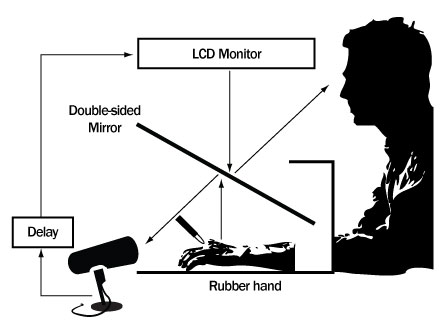300 milliseconds from hand to head
Experiment finds “rubber hand illusion” fails to work with too much delay
- More than 2 years ago
The hand is quicker than the eye, but only by about 300 milliseconds. That’s the time window in which the mind can be tricked into incorrectly linking something it sees with something it feels, Sotaro Shimada of Meiji University in Kawasaki, Japan, and colleagues report July 9 in PLoS ONE. The new work, which uses the “rubber hand illusion,” could help researchers better understand how and where the brain processes sensory information.

In the classic rubber hand illusion, a subject rests one arm on a table. Researchers hide the arm from view with a screen and place a rubber hand on the table directly in front of the subject. Both the rubber hand and the person’s hidden hand are stroked with a paintbrush. When the hands are stroked in sync, subjects report feeling as if the rubber hand is their own hand. And when asked to close their eyes and indicate where their hand is resting on the table, subjects think their hand is nearer to the rubber hand than it actually is.
In the new experiments, Shimada and colleagues placed a double-sided mirror over both the rubber and the real hands. A video camera filmed the rubber hand’s reflection in the mirror and projected it onto the top of the mirror, so the rubber hand appeared to be resting on the table. For three minutes, subjects focused on the image of the rubber hand while both it and their real hand were stroked with a brush. The researchers then incrementally increased the time delay, so the subjects felt the stroke before it appeared on the screen.
When the delay was greater than 300 milliseconds, the subjects were far less likely to report that the stroking sensation was happening to them.
The 300-millisecond window is “tantalizing,” says neuroscientist Christopher Moore of the McGovern Institute at MIT. It nicely narrows down the pool of processes that could explain the illusion’s success. “The time constraint [the researchers] provide us could be a great roadmap for looking at phenomena in the brain that respect that time frame,” Moore says.
The degree to which subjects misidentified the location of their own hand also diminished after 300 milliseconds, reemphasizing the overlap between how the brain distinguishes its own body and knows where the body is in space. Neurological damage, such as from a stroke, can mess with these mechanisms, as can alcohol (which is why attempting to touch one’s nose with the eyes closed will reveal the hand of a drinker).
The findings make big-picture sense, Moore says. “The job of the brain is to take the best information about what is going on now, and then to decide the best way to act in the next moment,” he says. In the rubber hand illusion, three senses are involved in processing information: touch, sight and proprioception — a sense of where one’s body parts are relative to each other. The brain tends to rely on the visual system, Moore says. But the new work shows that when these three senses are too far out of sync, the brain says “not so fast.”







